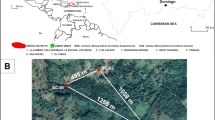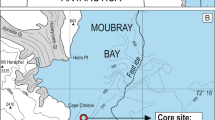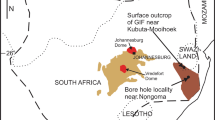Abstract
DURING April and May 1961 on a cruise of the R.V. Chain, a programme of coring deep-sea sediments from the Atlantic for geochemical investigations was conducted. At 19° 23′ N., 40° 53′ W. a modified Kullenberg corer was lowered through 4,430 m. of water to the summit of a rise on the ocean floor. The topography of the sea bed in this region is irregular, but between the hills and rises the average depth is approximately 4,900 m. At the point where the corer struck the sea bed the surface sediment is a red clay, but no sediment core was obtained since at a very short distance below the surface the red clay is underlain by solid material. The corer struck and broke the surface of this solid material, a fragment of which was recovered in the pilot corer, together with the overlying red clay. From the position of the solid fragment in ther pilot corer the thickness of the clay can be estimated to be not more than 38 cm. The solid fragment is a very dark brown, almost black natural glass of irregular shape, but with approximate dimensions 3 cm. × 2.5 cm. × 1.3 cm. Two faces of the fragment were freshly broken surfaces. On two other faces a thin (1 mm.) zone of devitrification occurs with small areas of manganese deposition on the outer surface. The two other faces appear to be natural fractures. Internally the fragment contains small irregular cavities about which slight devitrification has also occurred. When collected the fragment showed a marked tendency to disintegrate into smaller fragments, a consequence, no doubt, of the impact of the corer on the brittle glass. Red clay containing broken shards of the same glass was found adhering to the piston of the main corer, and it is likely, therefore, that the glass formation is too extensive to be interpreted as a boulder contained within the red clay. It is believed to represent the solid surface on which the overlying sediments rest. So far as is known this is the first sample collected of solid rock indisputably from below the sediments of the deep Atlantic.
This is a preview of subscription content, access via your institution
Access options
Subscribe to this journal
Receive 51 print issues and online access
$199.00 per year
only $3.90 per issue
Buy this article
- Purchase on Springer Link
- Instant access to full article PDF
Prices may be subject to local taxes which are calculated during checkout
Similar content being viewed by others
Author information
Authors and Affiliations
Rights and permissions
About this article
Cite this article
NICHOLLS, G., BOWEN, V. Natural Glass from beneath Red Clay on the Floor of the Atlantic. Nature 192, 156–157 (1961). https://doi.org/10.1038/192156a0
Issue Date:
DOI: https://doi.org/10.1038/192156a0
This article is cited by
-
Palagonite, hyaloclastites and alteration of volcanic glass in the ocean
Bulletin Volcanologique (1965)
Comments
By submitting a comment you agree to abide by our Terms and Community Guidelines. If you find something abusive or that does not comply with our terms or guidelines please flag it as inappropriate.



